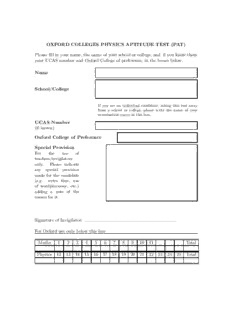
OXFORD COLLEGES PHYSICS APTITUDE TEST (PAT) Please fill PDF
Preview OXFORD COLLEGES PHYSICS APTITUDE TEST (PAT) Please fill
OXFORD COLLEGES PHYSICS APTITUDE TEST (PAT) Please fill in your name, the name of your school or college, and if you know them your UCAS number and Oxford College of preference, in the boxes below. Name School/College If you are an individual candidate, taking this test away from a school or college, please write the name of your examination centre in this box. UCAS Number (if known) Oxford College of Preference Special Provision For the use of teachers/invigilators only. Please indicate any special provision made for the candidate (e.g. extra time, use of wordprocessor, etc.) adding a note of the reason for it. Signature of Invigilator: ........................................................................ For Oxford use only below this line Maths 1 2 3 4 5 6 7 8 9 10 11 Total Physics 12 13 14 15 16 17 18 19 20 21 22 23 24 25 Total THE COLLEGES OF OXFORD UNIVERSITY PHYSICS Specimen of Written Test Issued May 2009 Time allowed: 2 hours For candidates applying for Physics, and Physics and Philosophy There are two parts (A and B) to this test, carrying equal weight. Answers should be written on the question sheet in the spaces provided and you should attempt as many questions as you can from each part. Marks for each question are indicated in the right hand margin. There are a total of 100 marks available and total marks for each section are indicated at the start of a section. You are advised to divide your time according to the marks available, and to spend equal effort on parts A and B. No calculators, tables or formula sheets may be used. Answers in Part A should be given exactly unless indicated otherwise. Numeric answers in Part B should be calculated to 2 significant figures. −2 Use g = 10ms . Do NOT turn over until told that you may do so. Part A: Mathematics for Physics [50 Marks] 1. If p = √3 and q = √2 evaluate (5p 4q)2 (4p 5q)2 . q − − − [3] 2. Find the set of real numbers λ for which the quadratic equation 2 x +(λ 3)x+λ = 0 − has distinct, real roots for x. [4] 2 3. (i) Draw sketches of the functions sinx and sin x over the range 2π < x < 2π. (Label the axes). [2] − (ii) Explain why, for the range 0 < x < π/2, sinx is smaller than tanx. . [2] 2 1 4 (iii) Using the equality cos θ = (1+cos2θ) or otherwise, express cos θ in 2 terms of cos2θ and cos4θ. [3] 4. Show that (3,4), ( 4,0) and (0, 2) are the vertices of a right-angled − − triangle, and find its area. [5] 5. Find the value of x for which (i) log x = 2, [1] 2 (ii) log 2 = 2, [1] x (iii) log 2 = x. [1] 2 6 6. Evaluate (2.002) to 4 decimal places. [4] 7. A ball is dropped vertically from a height h onto a flat surface. After the th n n bounce it returns to a height h/(3 ). Find the total distance travelled by the ball. [4] 8. (i) Sketch the curve y = 2 x +1 for 1 x 1. [2] | | − ≤ ≤ (ii) Find the area between the curve y = 2 x +1, the x-axis, and the lines | | x = 1 and x = 1. [2] − 9. Two identical dice are thrown, one after the other. What are the probabilities that (i) the total of the numbers shown is 6, [2] (ii) the second number is greater than the first? [4] 10. A geometric progression and an arithmetic progression have the same first term. The second and third terms of the geometric progression (which are distinct) are equal to the third and fourth terms of the arithmetic progression respectively. (i) Find the common ratio of the geometric progression. [2] (ii) Show that the fifth term of the arithmetic progression is zero. [3] 3 11. What are the largest and smallest values of y = x 12x+1 for values of x − in the range 3 to +5? [5] −
Description: